

The 5 Different Types of Speech Styles
Human beings have different ways of communicating . No two people speak the same (and nor should they). In fact, if you’ve paid any attention to people’s speeches around you, you might have already noticed that they vary from speaker to speaker, according to the context. Those variations aren’t merely coincidental.
The 5 Different Types of Speech Styles (Table)
| Frozen/Fixed Style | -Formal rigid and static language, reliant on expertise;-Particular vocabulary, previously agreed upon, that rejects slang. | -Formal settings and important ceremonies.-Speaker to an audience without response. | -Presidential speech;-Anthem;-School creed;-The Lord’s prayer. |
| -Formal language; -Particular, previously agreed upon vocabulary yet more allowing of slang, contractions, ellipses and qualifying modal adverbials;-Writing and speaking. | -Speaking and writing in formal and professional settings, to medium to large groups of people;-Speaking and writing to strangers, figures of authority, professionals and elders. | -Formal meetings;-Corporate meetings;-Court;-Speeches and presentations; -Interviews;-Classes. | |
| -Semi-formal vocabulary;-Unplanned and reliant on the listener’s responses;-May include slang, contractions, ellipses and qualifying modal adverbials. | -Two-way communication and dialogue, between two or more people, without intimacy or acquaintanceship. | -Group discussions; -Teacher-student communication; -Expert-apprentice communication; -Work colleagues communication;-Employer-employee communication; -Talking to a stranger. | |
| Casual Style | -Casual, flexible and informal vocabulary;-Unplanned and without a particular order;-May include slang, contractions, ellipses and qualifying modal adverbials. | -Relaxed and casual environments; -Two or more people with familiarity and a relatively close relationship. | -Chats with friends and family;-Casual phone calls or text messages. |
| Intimate Style | -Casual and relaxed vocabulary. -Incorporates nonverbal and personal language codes (terms of endearment, new expressions with shared meaning). -May include slang, contractions, ellipses and qualifying modal adverbials. | -Intimate settings, relaxed and casual environments; -Two or more people with an intimate bond. | -Chats between best friends, boyfriend and girlfriend, siblings and other family members, whether in messages, phone calls, or personally. |
1. Frozen Style (or Fixed speech)
A speech style is characterized by the use of certain grammar and vocabulary particular to a certain field, one in which the speaker is inserted. The language in this speech style is very formal and static, making it one of the highest forms of speech styles. It’s usually done in a format where the speaker talks and the audience listens without actually being given the space to respond.
Application: It’s generally reserved for formal settings such as important ceremonies (for instance, a ceremony at the royal palace or one in which a country’s president is present), weddings, funerals, etc.
2. Formal Style
This style, just like the previous one, is also characterized by a formal (agreed upon and even documented) vocabulary and choice of words, yet it’s more universal as it doesn’t necessarily require expertise in any field and it’s not as rigid as the frozen style.
3. Consultative Style
The third level of communication it’s a style characterized by a semi-formal vocabulary, often unplanned and reliant on the listener ’s responses and overall participation.
4. Casual Style (or Informal Style)
Application: used between people with a sense of familiarity and a relatively close relationship, whether in a group or in a one-on-one scenario.
Examples: chats with friends and family, casual phone calls, or text messages.
5. Intimate Style
Examples: chats between best friends, boyfriend and girlfriend, siblings and other family members, whether in messages, phone calls, or personally.
The 4 Methods or Types of Speech Delivery
What makes a great presenter 9 key qualities to look for, an easy guide to all 15 types of speech, 4 factors that influence speech styles.
Although knowing the definition and some examples of situations in which each speech style might apply is helpful, there are four important factors that are key in speech styles. These factors help the speakers understand when it is appropriate to use one style instead of the other. They are:
1. The Setting
Although it’s a factor that’s exhausted and diverse, to make things simple for you, I’ve divided them in three main categories:
Misreading the setting can be really embarrassing and have devastating consequences. If, for instance, you make inappropriate jokes in a work meeting or use slang words, you could be perceived as unprofessional and disrespectful, and that could cost you your job.
2. The Participants
3. the topic .
For example, sometimes, when making a presentation about a serious topic at a conference, you might want to mix formal speech with a more consultative or casual speech by sliding in a joke or two in between your presentation, as this helps lighten up the mood.
4. The Purpose of The Discourse or Conversation
Speaker styles.
A content-rich speaker is one whose aim is to use the speech to inform. He is factual and very objective and focused on providing all the information the audience or receptor of the message needs.
Most TED talkers or motivational speakers are great examples of this type of speaker.
What’s The Importance of Speech Styles In Communication
Besides that, people tend to gravitate more towards and get influenced by good communicators; therefore, learning something new in that area and improving the quality of your speech and presentations will only benefit you.
Further Readings
Similar posts, 6 solid tips about making eye contact, smooth transition in a speech – 69 transition statements, 8 awesome persuasive speech techniques & topics, why a speech outline is important, designing a killer presentation in 8 steps, want to stand out 15 key tips for an awesome presentation.

Speech Types – PowerPoint
by Lauren McCool | Sep 12, 2017
Speech Types - PowerPoint
Teacher in a Box
The 8 Types of Presentation Styles: Which Category Do You Fall Into?
Updated: December 16, 2020
Published: September 24, 2018
Types of Presentations
- Visual Style
- Freeform Style
- Instructor Style
- Coach Style
- Storytelling Style
- Connector Style
- Lessig Style
- Takahashi Style
Everyone on the internet has an opinion on how to give the “perfect” presentation.

One group champions visual aids, another thinks visual aids are a threat to society as we know it. One expert preaches the benefits of speaking loudly, while another believes the softer you speak the more your audience pays attention. And don’t even try to find coordinating opinions on whether you should start your presentation with a story, quote, statistic, or question.
But what if there wasn’t just one “right” way to give a presentation? What if there were several? Below, I’ve outlined eight types of presentation styles. They’re used by famous speakers like Steve Jobs and Al Gore -- and none of them are wrong.
Check out each one and decide which will be most effective for you.
![type of speech style ppt → Free Download: 10 PowerPoint Presentation Templates [Access Now]](https://no-cache.hubspot.com/cta/default/53/2d0b5298-2daa-4812-b2d4-fa65cd354a8e.png)
Types of Presentation Styles
1. visual style.
What it is: If you’re a firm believer slides simply exist to complement your talking points, this style is for you. With this speaking style, you might need to work a little harder to get your audience engaged, but the dividends can be huge for strong public speakers, visionaries, and storytellers.
When to use it: This style is helpful when speaking to a large audience with broad interests. It’s also great for when you need to throw together slides quickly.
Visual style presenter: Steve Jobs
2. Freeform Style
What it is: This impromptu style of presenting doesn’t require slides. Instead, the speaker relies on strong stories to illustrate each point. This style works best for those who have a short presentation time and are extremely familiar with their talking points.
When to use it: Elevator pitches, networking events, and impromptu meetings are all scenarios in which to use a freeform style of speaking. You’ll appear less rehearsed and more conversational than if you were to pause in the middle of a happy hour to pull up your presentation on a tablet.
Freeform style presenter: Sir Ken Robinson
3. Instructor Style
What it is: This presentation style allows you to deliver complex messages using figures of speech, metaphors, and lots of content -- just like your teachers and professors of old. Your decks should be built in logical order to aid your presentation, and you should use high-impact visuals to support your ideas and keep the audience engaged.
When to use it: If you’re not a comfortable presenter or are unfamiliar with your subject matter (i.e., your product was recently updated and you’re not familiar with the finer points), try instructor-style presenting.
Instructor style presenter: Al Gore
4. Coach Style
What it is: Energetic and charismatic speakers gravitate towards this style of presenting. It allows them to connect and engage with their audience using role play and listener interaction.
When to use it: Use this presentation style when you’re speaking at a conference or presenting to an audience who needs to be put at ease. For example, this style would work well if you were speaking to a group of executives who need to be sold on the idea of what your company does rather than the details of how you do it.
Coach style presenter: Linda Edgecombe
5. Storytelling Style
What it is: In this style, the speaker relies on anecdotes and examples to connect with their audience. Stories bring your learning points to life, and the TED’s Commandments never let you down: Let your emotions out and tell your story in an honest way.
When to use it: Avoid this style if you’re in the discovery phase of the sales process. You want to keep the conversation about your prospect instead of circling every point or question back to you or a similar client. This style is great for conference speaking, networking events, and sales presentations where you have adequate time to tell your stories without taking minutes away from questions.
Storytelling style presenter: Jill Bolte Taylor
6. Connector Style
What it is: In this style, presenters connect with their audience by showing how they’re similar to their listeners. Connectors usually enjoy freeform Q&A and use gestures when they speak. They also highly encourage audience reaction and feedback to what they’re saying.
When to use it: Use this style of presenting early in the sales process as you’re learning about your prospect’s pain points, challenges, and goals. This type of speaking sets your listener at ease, elicits feedback on how you’re doing in real time, and is more of a dialogue than a one-sided presentation
Connector style presenter: Connie Dieken
7. Lessig Style
What it is: The Lessig Style was created by Lawrence Lessig , a professor of law and leadership at Harvard Law School. This presentation style requires the presenter to pass through each slide within 15 seconds. When text is used in a slide, it’s typically synchronized with the presenter’s spoken words.
When to use it: This method of presentation is great for large crowds -- and it allows the speaker to use a balance of text and image to convey their message. The rapid pace and rhythm of the slide progression keeps audiences focused, engaged, and less likely to snooze.
Lessig style presenter: Lawrence Lessig
8. Takahashi Style
What it is: This method features large, bold text on minimal slides. It was devised by Masayoshi Takahashi , who found himself creating slides without access to a presentation design tool or PowerPoint. The main word is the focal point of the slide, and phrases, used sparingly, are short and concise.
When to use it: If you find yourself in Takahashi’s shoes -- without presentation design software -- this method is for you. This style works well for short presentations that pack a memorable punch.
Takahashi style presenter: Masayoshi Takahashi
Slides from one of Takahashi’s presentations:
Whether you’re speaking on a conference stage or giving a sales presentation , you can find a method that works best for you and your audience. With the right style, you’ll capture attention, engage listeners, and effectively share your message. You can even ask an AI presentation maker tool to create presentations for you in your preferred style
![type of speech style ppt Blog - Beautiful PowerPoint Presentation Template [List-Based]](https://no-cache.hubspot.com/cta/default/53/013286c0-2cc2-45f8-a6db-c71dad0835b8.png)
Don't forget to share this post!
Related articles.
![type of speech style ppt 10 Best Sales Presentations To Inspire Your Sales Deck [+ 5 Tips]](https://www.hubspot.com/hubfs/sales-deck.jpg)

10 Best Sales Presentations To Inspire Your Sales Deck [+ 5 Tips]

15 Sales Presentation Techniques That Will Help You Close More Deals Today

9 Ways to End Your Sales Presentation With a Bang

7 Apps That Help Salespeople Become Even Better Speakers

7 Secrets of a Winning Capabilities Presentation

Insight Selling: The 8-Slide Framework for a Better Pitch

The Best Work-Appropriate GIFs to Use in Your Next Sales Slide Deck
![type of speech style ppt How to Make a Business Presentation in 7 Easy Steps [Free Business Presentation Templates]](https://53.fs1.hubspotusercontent-na1.net/hubfs/53/how-to-make-a-business-presentation.jpg)
How to Make a Business Presentation in 7 Easy Steps [Free Business Presentation Templates]

How to Handle Difficult Sales Calls Like a Pro

Technology Give You the Middle Finger in a Demo? 7 Reactions to Avoid
Download ten free PowerPoint templates for a better presentation.
Powerful and easy-to-use sales software that drives productivity, enables customer connection, and supports growing sales orgs
- Preferences

Types of speech - PowerPoint PPT Presentation

Types of speech
This presentation will cover the different styles of speeches, including informative, persuasive, entertaining, and special occasion speeches, and provide tips and techniques for delivering an effective speech in each category. whether you're a student, a professional, or just looking to improve your public speaking skills, this presentation is designed to help you become a more confident and compelling speaker. – powerpoint ppt presentation.
- Impromptu speaking
- Extemporaneous
- Manuscript speaking
- Memorized speaking
- Informative/Expository
- Persuasive Speech
- Entertainment Speech
- Ceremonial Speeches
- Inspirational Speech
- Informative Speech
- Simply put, this is about helping audience members acquire information that they do not already possess.
- When we speak to persuade, we attempt to get listeners to embrace a point of
- view or to adopt a behavior that they would not have done otherwise.
- The fundamental goal of an entertaining speech is audience enjoyment, which can come in a variety of forms.
- www.sudo24.com
- Impromptu Speaking
- is the presentation of a short message without advance preparation.
- Extemporaneous Speaking
- is the presentation of a carefully planned and rehearsed speech, spoken in a conversational manner using brief notes.
- Manuscript Speaking
- is the word-for-word iteration of a written message.
- Memorized Speaking
- is the rote recitation of a written message that the speaker has committed to memory.
- are speeches given during a ceremony or a ritual
- marked by observance of formality or etiquette.
- The goal of an inspirational speech is to elicit or arouse
- an emotional state within an audience.
- It is the most formal speech style
- that is usually used in formal contexts such as speech for state ceremonies, court proceedings, and religious rituals.
PowerShow.com is a leading presentation sharing website. It has millions of presentations already uploaded and available with 1,000s more being uploaded by its users every day. Whatever your area of interest, here you’ll be able to find and view presentations you’ll love and possibly download. And, best of all, it is completely free and easy to use.
You might even have a presentation you’d like to share with others. If so, just upload it to PowerShow.com. We’ll convert it to an HTML5 slideshow that includes all the media types you’ve already added: audio, video, music, pictures, animations and transition effects. Then you can share it with your target audience as well as PowerShow.com’s millions of monthly visitors. And, again, it’s all free.
About the Developers
PowerShow.com is brought to you by CrystalGraphics , the award-winning developer and market-leading publisher of rich-media enhancement products for presentations. Our product offerings include millions of PowerPoint templates, diagrams, animated 3D characters and more.

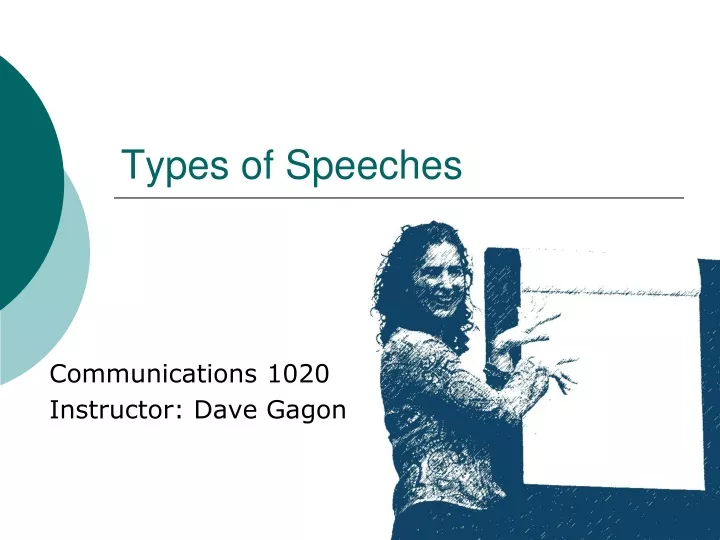
Types of Speeches
Jan 01, 2020
120 likes | 203 Views
Types of Speeches. Communications 1020 Instructor: Dave Gagon. Types of Speeches. Informative Persuasive Special occasion. Informative Speech. Provides: New information New insights New ways of thinking about a topic It ’ s Goal: Increase understanding or awareness
Share Presentation
- informative speech
- persuasive speech
- special occasion
- listeners view things
- sample persuasive speech topics

Presentation Transcript
Types of Speeches Communications 1020 Instructor: Dave Gagon
Types of Speeches • Informative • Persuasive • Special occasion
Informative Speech • Provides: • New information • New insights • New ways of thinking about a topic • It’s Goal: • Increase understanding or awareness • Can be about objects, people, events, processes, concepts, issues
SAMPLE INFORMATIVE SPEECH TOPICS • Hydrogen-powered Cars • Staying Healthy on a Vegetarian Diet • WikiWikiWikiWebs – Taking Interactive to a New Level • SuperSlow Exercise • Top Ten Conspiracy Theories • Advances in Breast Cancer Treatments
Persuasive Speech • Intended to influence: • Attitudes • Beliefs • Values • Acts of others • Speech represents two viewpoints • Try to sway audience to your side through ethical means
SAMPLE PERSUASIVE SPEECH TOPICS • Become an Organ Donor • Adopt a Foster Child • Take Calcium Supplements for Health • The NBA Draft Needs Fixing • Procrastination Hurts • Spay or Neuter Your Pets • Treat the Disabled with Dignity, Respect and Fairness
Special Occasion Speech • Prepared for a specific occasion and for a purpose dictated by that occasion. • Can be either informative or persuasive – often a mix of both • Main function is to entertain, celebrate, commemorate, inspire, or set a social agenda
CHECKLIST: Identifying Speech Types • Is your goal in speaking primarily to increase the audience’s knowledge of a topic or to share your point of view? (Your speech is informative in nature.) • Is it primarily to effect some degree of change in the way your listeners view things? (Your speech is persuasive in nature.) • Is it primarily to entertain, celebrate, commemorate, inspire or set a social agenda? (Your speech is a special occasion speech.)
- More by User
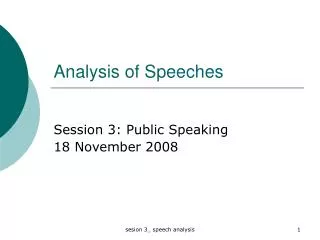
Analysis of Speeches
Analysis of Speeches. Session 3: Public Speaking 18 November 2008. Introduction to speech analysis. Barack Obama: President-Elect of the United States. To be inaugurated as the American President on January 20, 2009. Barak Obama.
530 views • 28 slides
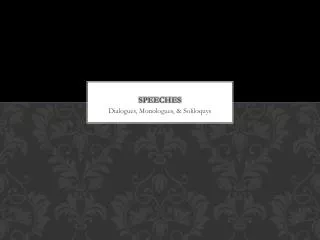
Speeches. Dialogues, Monologues, & Soliloquys. What is Dialogue?. A conversation between two or more people Example: Lines 62-111 What makes this dialogue?. What Is a Monologue?. A long, uninterrupted speech by one person to an audience in the play Example: Lines 211-231
328 views • 13 slides

SPEECHES. Keys to Success. Posture. Erect posture indicates = Extreme erect posture indicates = Slump indicates = Leaning towards someone = Leaning away from someone = . Space & Movement. Cultural differences Elevators or doctors’ offices Benefits of movement Detriments of movement.
420 views • 9 slides

speeches. To start …. Why am I giving this speech ? Who is the audience ? What is my purpose ? Am I informing the audience ? Persuading them ? Entertaining them ? Am I giving a report ?. How to deliver . http://www.youtube.com/watch?v=--jQ-Q06qlc Watch the above link.
246 views • 8 slides

Speeches. Effective speakers, successful speeches…and inquiry . Learning Objectives:. Can I identify and explain what makes a successful speech? Can I identify and explain what makes an effective speaker?. Effective Speeches and Speakers. Mini-Plenary!. Think-Pair-Share
265 views • 10 slides

Speeches. Non-fiction unit. Background. In the 1950’s, the population in the US was increasing due to the baby-boom, after WWII.
258 views • 11 slides
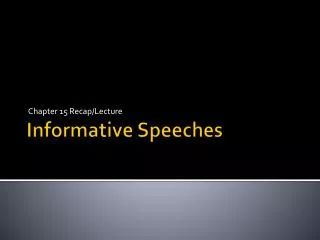
Informative Speeches
Chapter 15 Recap/Lecture. Informative Speeches. Purpose. To inform; not to advocate Goal is to provide understanding and knowledge. Types of Informative Speeches. Speeches about objects Speeches about processes Speeches about concepts. General Guidelines. Don’t overestimate or assume
331 views • 7 slides

Speeches. A speech, like a play, must be written to be heard, not read. P a i n t a Picture with Words.
392 views • 20 slides

SPEECHES “DECLARATION OF SENTIMENTS”
SPEECHES “DECLARATION OF SENTIMENTS”. “ DECLARATION OF SENTIMENTS” *Purpose – To persuade the US that women had rights and give them solutions *Where and When – Seneca Falls, NY 1848 *Significance – Put an emphasis on rights for women *Modeled after what documents –
289 views • 4 slides

Types of Speeches. Objective:. Students will be introduced to different formats of speeches and the rhetorical devices that are used in speeches. . Sequential. Speeches that go in order. They use the words –“first,” “second,” “third,” “next,” “last,” and “finally.”
845 views • 16 slides

Types of Informative Speeches: Analysis and Organization
Types of Informative Speeches: Analysis and Organization. Barry 2010. Importance of Informative Speaking. Survey of graduates from 5 U.S. colleges: Respondents asked to rank the speech skills most important to their jobs: Informative speaking was rated number one. Another survey:
612 views • 21 slides

Speeches. Background. In the 1950’s, the population in the US was increasing due to the baby-boom, after WWII.
263 views • 11 slides

Speeches. Speeches are (M) 10/24 and (F) 10/28. Write you name on your piece of paper and pass back to me . -Don’t be late or you will interrupt the first speaker. -Plan on going over a few minutes on Friday. (*I’ll compensate on another day.) Speech Tips
380 views • 7 slides

SPEECHES. Vocal Considerations. NOTES. Speeches should never be read. TONE. Speeches should have a conversational feel. PACING. Speeches should have a relaxed speed – not too fast. PAUSING. Avoid verbal pauses (um…, like, you know) Use silent pauses for emphasis of points. VOLUME.
301 views • 6 slides
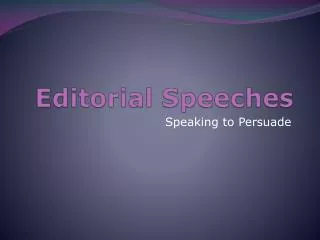
Editorial Speeches
Editorial Speeches. Speaking to Persuade. Editorial speeches. Your primary purpose is to persuade! Take a stand on an issue. If you cannot take a clear stand, you do not have a good editorial. Step 1: Choose a Topic. Pick a topic reflecting recent news events. What are hot issues?
319 views • 10 slides

Speeches. Spring 2014. Looking for literary Devices . Help the speech-giver to make an impression Help add to the meaning of the speech Helps certain points being made to STICK OUT . Aphorism. A concise statement of a general truth or principle Ex. A penny saved is a penny earned
282 views • 12 slides

Types of Informative Speeches
Types of Informative Speeches . How to save people from; How to buy a used car; how to write an effective job resume; how perfume is made… Cosmetic surgery; television viewing; Halloween; jobs interviews… Principles of psychology; Islam; Extinction of dinosaurs….
671 views • 10 slides

Speeches. Play. Help and Reminders. Attention Getting Devices. When delivering a speech, it is important to employ certain strategies that not only gain the audience’s attention but also make connections to your topic.
389 views • 16 slides

Speeches. Animal Translator. Business In China. Showing “face” Time Respect is the key to success. Doing Business with the Chinese Culture. Dates and Planning Preparation Dress Code Introductions. Culture of the Chinese. Chinese Zodiac relates to animals. Dragons Lions.
319 views • 9 slides
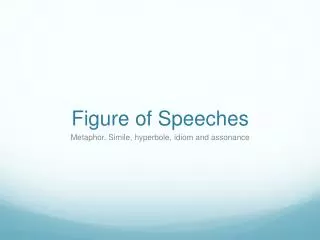
Figure of Speeches
Figure of Speeches. Metaphor, Simile, hyperbole, idiom and assonance. Metaphor. a term or phrase is applied to something to which it is not literally applicable in order to suggest a resemblance without using like or as. Example: “A mighty fortress is our God.”. Simile.
305 views • 6 slides

Speeches. Speeches. A speech is a nonfiction work that is delivered orally to an audience. Some speeches are composed in writing before they are spoken aloud. Others are composed less formally as they are being presented, usually with notes as a guide. Types of Speeches.
647 views • 28 slides
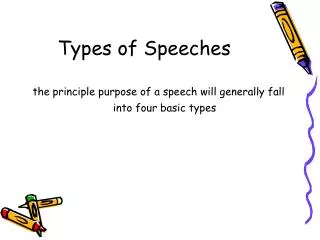
Types of Speeches. the principle purpose of a speech will generally fall into four basic types. Informative Persuasive Entertaining technical. Informative speech. In an informative speech you Explain something to people Help people to understand something Show them how to do something.
8.57k views • 24 slides

- My presentations
Auth with social network:
Download presentation
We think you have liked this presentation. If you wish to download it, please recommend it to your friends in any social system. Share buttons are a little bit lower. Thank you!
Presentation is loading. Please wait.
To view this video please enable JavaScript, and consider upgrading to a web browser that supports HTML5 video
4 Types of Speeches The four basic types of speeches are: to inform, to demonstrate, to entertain, and to persuade. These are not mutually exclusive of.
Published by Alexandrina Foster Modified over 8 years ago
Similar presentations
Presentation on theme: "4 Types of Speeches The four basic types of speeches are: to inform, to demonstrate, to entertain, and to persuade. These are not mutually exclusive of."— Presentation transcript:

Objectives: At the end of the class, students will (hopefully) be able to: Explain the importance of a good presentation List the steps they will take.

Ms. Christoph ESE~Intensive Reading

Public Communication Introduction to Public Speaking.

Authors Purpose and Perspective. An author has a purpose for writing. An author may write to entertain. An author may write to inform. An author may write.

Persuasive Writing – The Basics

Why does an author write a story?

It's test time again and you've just finished reading the first paragraph in the test booklet and are preparing to answer the questions. The first question?

Partner share Describe a movie where a toy comes to life. Learning Objective: We are going to understand that there is always a purpose for a piece of.

What is the Author’s Purpose?

Author’s Purpose Reasons for Writing.

ENG101 - Speaking Module Selecting the topic for your presentation

Author’s Purpose Standards: ELACC8RI1 (Cite textual evidence) ELACC8RI6 (Determine POV or purpose in text) ELACC8RI7 (Evaluate use of different mediums)

The First Amendment Congress shall make no law respecting an establishment of religion or prohibiting the free exercise thereof; or abridging the freedom.

Recognizing Purpose and Audience in Media Texts

Chapter 9 Getting Ready. How to Prepare for a Speech The key to a successful speech is to ________________. The key to a successful speech is to ________________.

1.Format 2.Audience 3.Topic 4.Purpose. Identifying the format helps you decide how to organize your paper. Example formats: Narrative (telling a story)

Types of Speeches Mr.Rossin.

Donielle Speranza Christine McDonald Anthony Sylvester.

HOW IS SPEECH PRODUCED? SPEAKING IN PUBLIC PREPARING A SPEECH CREATING & CONDUCTING AN EFFECTIVE SPEECH PERSUASIVE SPEECH Speech vs. Language.

Why am I giving this speech ? Who is the audience ? What is my purpose ? Am I informing the audience ? Persuading them ? Entertaining them ? Am.
About project
© 2024 SlidePlayer.com Inc. All rights reserved.

IMAGES
VIDEO
COMMENTS
The 5 Different Types of Speech Styles (Table) Types of Speech Styles. Description. Application. Example. Frozen/Fixed Style. -Formal rigid and static language, reliant on expertise;-Particular vocabulary, previously agreed upon, that rejects slang. -Formal settings and important ceremonies.-Speaker to an audience without response.
1. Work in Group in 5 groups. 2. Advertise a deodorant using the assigned speech style to you group. 3. You have 5 minutes to prepare a 1 minute skit. SCORE DESCRIPTORS. 20-The words, attitude, tone of voice, facial expressions and overall body language of the speaker are appropriate for the setting.
Presentation Transcript. Types of Speeches the principle purpose of a speech will generally fall into four basic types. Informative • Persuasive • Entertaining • technical. Informative speech In an informative speech you • Explain something to people • Help people to understand something • Show them how to do something.
Speech Types - PowerPoint. by Lauren McCool | Sep 12, 2017. Speech Types - PowerPoint. Teacher in a Box (920) 748-6206 [email protected] Create an Account ...
3. Instructor Style. What it is: This presentation style allows you to deliver complex messages using figures of speech, metaphors, and lots of content -- just like your teachers and professors of old. Your decks should be built in logical order to aid your presentation, and you should use high-impact visuals to support your ideas and keep the audience engaged.
This presentation will cover the different styles of speeches, including informative, persuasive, entertaining, and special occasion speeches, and provide tips and techniques for delivering an effective speech in each category. Whether you're a student, a professional, or just looking to improve your public speaking skills, this presentation is designed to help you become a more confident and ...
Types of Speeches Communications 1020 Instructor: Dave Gagon. Types of Speeches • Informative • Persuasive • Special occasion. Informative Speech • Provides: • New information • New insights • New ways of thinking about a topic • It's Goal: • Increase understanding or awareness • Can be about objects, people, events ...
1 4 Types of Speeches The four basic types of speeches are: to inform, to demonstrate, to entertain, and to persuade. These are not mutually exclusive of one another. You may have several purposes in mind when giving your presentation. For example, you may try to inform in an entertaining style.
3. TURN-TAKI NG Pertains to the process by which people decides who take the conversational floor. Mainly, the idea is to give all communicators a chance to speak 4. TOPIC CONTROL Covers how procedural formality or informality affects the development of topics in conversation. 5.